Para Bellum is played over several rounds, beginning with the first player (see step 7 in “Setup”).
A Player’s turn consists of 3 phases:
- 1) Army Phase
- 2) Action Phase
- 3) Draw Phase
Army Phase
Play an Army card from your hand and add it to the battlefield. It must attach to another Army card on at least one side. Your starting card also counts as an Army card for this purpose. If it is put beside another Army card, the color of the legion on the two touching sides must match. If you place your Army card to the side of another card, a black square is created. If you add it above or below an Army card, a red square is created.
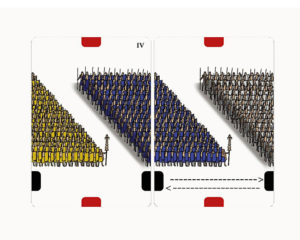
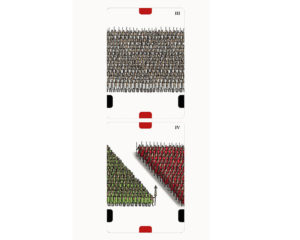
If you completed a legion by playing an Army card, (i.e. the color you played is completed on both sides of the legion), gain and roll a black Legion die for every black square in this legion. After rolling the Legion dice, place them on the black squares with their rolled results face up. If you roll a 1 or 2, you may take a face-up Command card from the table.
If you completed a red square by playing an Army card above or below another Army card, gain and roll a red Commander die. Place that die on the red square with its rolled result face up. After placing a Commander die, take a red Commander token or a black Legion token and place it under one of your matching dice. Note: This does not have to be the same die you just rolled, and you may not pick a die which already has a token under it. Red Commander tokens go under red Commander dice and black Legion tokens go under black Legion dice.
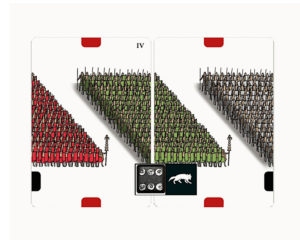

You can only place Army cards in the row directly under your starting card, in the same row as your starting card, or in the 2 rows above your starting card. Therefore, your battlefield can have at most 4 rows. Each row may only be 9 cards wide. (i.e. You may not have more than 4 cards on either side of your starting card.) All rows have the same maximum length, meaning the borders of all rows are the same column on either side.
Some Command cards specifically state that they go to your battlefield. These follow the same placement rules as Army cards, but must also connect to create a square. If a Command card does not have part of a square on its side, then no Army card may be played next to it. In some rare cases, you will not be able to place an Army card, but if you can place an Army card, you must do so.
Placing an Army card can cause you to roll Commander dice and Legion dice in the same Army phase. Roll all new dice at the same time. When you place an Army card, but no new legion is finished (i.e. the legion still needs to be closed up), you do not gain nor roll a Legion die. This happens with big or massive legions, which span more than 2 cards.
After you complete a big legion (spanning 3 or more cards), you get a reward from the Battle Reward card and your opponent must take a morale check. Battle Reward cards and morale checks are explained later.
At the end of the Army phase, check to see if you finished a legion of any color for the first time. If you did, place the corresponding Color Banner near your battlefield. When a player places their 5th Color Banner, the end of the game is triggered.

Battle Reward Cards
There are three Battle Reward cards, but you only play with one each game.
When you complete a legion spanning 3 or more cards, and after you acquire and roll any new Legion dice, you get a bonus from the Battle Reward card. The bonus you get corresponds with the color of the legion you just completed. So, if you complete a red legion, you get the red bonus. However, if you complete a legion matching your starting card, you may pick any of the bonuses on the Battle Reward card.
Example: Taylor’s starting Army card was blue. She just finished a massive blue legion in her battlefield, so she may choose any bonus on the Battle Reward card, because the blue legion she finished matches her starting color.
Action Phase
In a 2- or 3-player game, you may take up to 3 actions. In a 4-player game, you may take up to 2 actions. You may take the same action multiple times, unless otherwise stated on the card or in this rule book. When taking an action, place your Centurion Action token on the first space of your reference card to show you’ve taken one action. Move the Centurion to the next space for your next action, and so on. This helps you keep track of how many actions you have left.
Command:
Play a Command card with the keyword “Order” from your hand. Follow the instructions on the card. Sometimes Command or Legion tokens will improve the effect of the card. After it is used, the Command card is put face up on the discard pile.
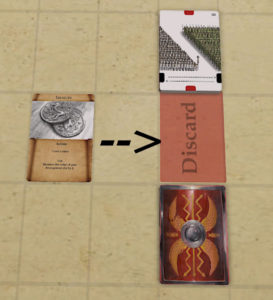
Deploy:
Play a Command card with the keyword “Permanent” to your battlefield or play area.
“Special Unit” cards go to the battlefield and are played above an Army card. The top and bottom of your Special Unit card may touch the top or bottom of an Army card already in your battlefield, but their long sides may not touch Army cards. No die is placed on the red square that is created from this placement.
“Construct” and “Character” cards are placed in your play area.
Playing construct cards costs 2 actions.
Permanent Command cards must first be played to your battlefield or play area before they can be used. After that, you can spend an action to activate them (see “Activate” below).
Example: Heather takes the Deploy action to play her Road card to her play area. This uses one action. Because this is a 4-player game, she has only one action left. She may use her final action to activate her Road card and use its action, or she could choose to do a different action.


Herold (4 Player only):
Place the Runner token on your Alliance card to take its action.
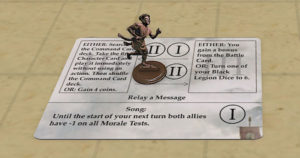
Blue General Die
Muster:
Reduce the General die by 1 to draw an Army card and add it to your hand.
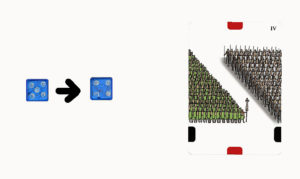
Empower:
Reduce the General die by 1 to increase the value of a Commander die in your battlefield by up to 2.Reduce the blue general die by one to increase the value of a red commander die in your battlefield by up to two.

Red Commander Die / Black Legion Die
Activate:
Use an ability on a permanent card in your battlefield or play area.
Each permanent card may only be used once per turn, even if it has more than one ability. To trigger these abilities, you must first have a die on top of a matching token, as stated on the card’s ability. Then, you must decrease that die’s value according to the ability you’re activating. After you used the ability, rotate the card 90° for the rest of the turn to show it has been used.
Example: Alastair spends one action to play “Archers” in his battlefield. Then, he spends 1 more action to use its ability. The card says to “spend 1 [Warlord] point” to use the ability. This means Alastair needs a [Warlord] Commander token. To pay for the action, he reduces the value of the die on the [Warlord] Commander token by 1. He can now use the ability. Alternately, Alastair could instead spend 1 coin. However, to use a coin, he must have a [Warlord] Commander token in play. Otherwise, he may not use the Archers ability, even if he had coins available.
You can only use one die to spend points for an action, and that die must be on top of the matching Legion or Commander token. When spending a point from a die, simply reduce its value by 1. If your Commander or Legion dice go below 1, they are removed from your battlefield. General dice may never go lower than 1. Coins can be spent instead of or in addition to using dice values, but you still must have the matching token on your battlefield to do so.
Card abilities can be used the same turn the card is played. While it takes 2 actions to play a construct card, its ability still costs a single action, just like all other permanent Command cards.
Alliance cards and Asset cards are also counted as permanent cards and can be activated.
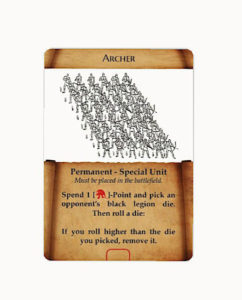
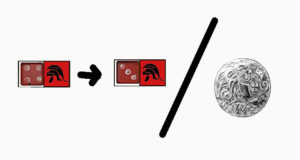
Consult:
Reduce a Commander die by 1 to draw a Command card.
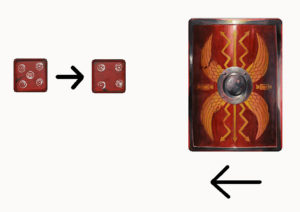
Motivate:
Reduce a Commander die by 1 to hold a speech. To do so, reroll one or both of the Legion dice diagonally above the card the Commander die is on. Coins cannot be used to perform this action.
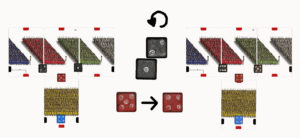
Requisition:
Discard 1 Army card from your hand to gain 1 coin.

Pass:
Do nothing.
Draw Phase
At the end of the turn, draw one Army card.
After drawing your Army card, check your hand limit. If you have 8 or more cards, you must discard down to 7 cards. This happens only during your Draw phase. You may have more than 7 cards in your hand at any other time.
Discarded Command cards go on top of the discard pile, face up. If you discard more than one card, you may choose the order of the discarded cards. Discarded Army cards are put face down at the bottom of the Army card deck.
